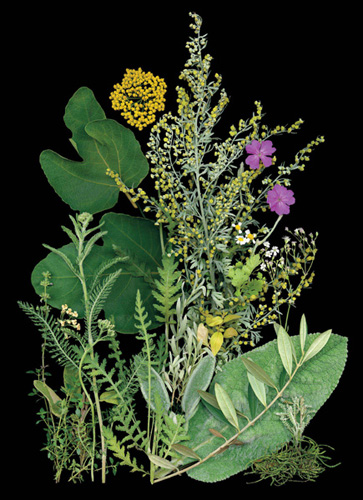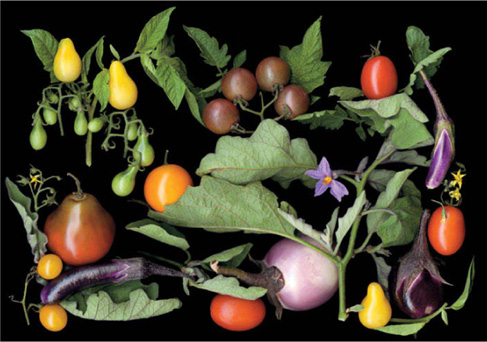
Mediterranean and similar plants A edible fig; B Achillea species (from the Greek hero Achilles); C Artemisia ludoviciana ‘Silver King’*; D Lychnis coronaria; E Tanacetum partheneum ‘Aureum’; F Gypsophila repens; G Olea europaea; H Stachys byzantina ‘Helene von Stein’; I Santolina chamaecyparissus; J S. virens;K Tanacetum vulgare;M Salvia officinalis ‘Icterina’; N Achillea ‘Schwellenberg’; O Lavandula angustifolia; P Origanum vulgare ‘Aureum’.

The countries bordering the Mediterranean Sea have a special climate, but one that is not unique to that part of the globe. Specific weather patterns and temperature conditions are shared by a few places within latitude 40 degrees north and 40 degrees south. These areas include the southwestern tip of Africa, a dot at the center of New Zealand, parts of Chile and China, Western Australia, and the coast of California.
In the countries touching the sea itself— Spain, Italy, Israel, Turkey, Algeria, Morocco, and others—the Moorish or Islamic style continues to bear a powerful influence. Cloistered gardens surrounded by walls, or in courtyards, with a central water runnel and fountain, evolved in part as responses to social and environmental factors: a need for privacy and security, weather and water.
With sufficient irrigation, the Mediterranean area is ideal for growing a wide range of food crops from spring through summer. No wonder agricultural crops have been cultivated there for thousands of years, helping civilizations develop and flourish. When plants put down roots, so do people.
Sea travel encouraged trade.
Many foods associated with one country originated elsewhere, like Ireland’s potato. Eggplant is popular in the Middle East and probably made it to Italy from there. Italy is associated with New World fruits like tomatoes, peppers, and zucchini from Central America. In a French fairy tale, Cinderella stepped out of a coach transformed from a pumpkin. Spain and Florida are famed for citrus, which came from Asia.
Although the Mediterranean is a subtropical region, many of its plants can tolerate colder climates, and cultivars have been selected that are bone-hardy: herbs like lavender (Lavandula angustifolia), a host of Artemisia varieties, lamb’s ears (Stachys bizantina), and many silver-leafed plants (here). The key is to provide excellent drainage year-round. When I think of Italy’s gardens, I picture Italian cypress (Cupressus sempervirens), those tall, slender evergreens that shoot up in the semiformal villa landscapes. Other people might think of red ripe tomatoes, or fragrant herbs. Many herbs familiar in Italy can also be grown in North America, like sage, oregano, marjoram, thyme, fennel, parsley, and mint.
Members of the Solanaceae family: tomatoes ‘Japanese Black Trifele’, ‘Yellow Pear’, purple ‘Black Cherry’, and plum ‘Juliette’; eggplants ‘Italian Long’, pale round ‘Rosa Bianca’, small Asian ‘Ping Tung’.

Chanticleer, the magnificent public garden in Wayne, Pennsylvania, has many newly designed plantings around a former estate, including this Moorish-style fountain and runnel beside the main house.